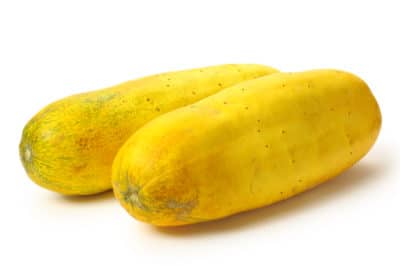The Cultural Connection
The chlorophyll responsible for the green color of most cucumbers masks yellow or orange pigments called carotenoids. When cultural problems reduce a plant’s chlorophyll production, the carotenoids in its fruit’s skin come to the surface. These problems include:
- Heavy leaf cover shading the fruit
- Direct afternoon sun scalding the fruit
- Soil that’s deficient in nitrogen or sulfur, which help cukes make chlorophyll.
- Leaf damage from disease or pests. It reduces photosynthesis, so the cukes have less energy to spend on chlorophyll production.
- Delayed harvesting. Unless you pick them at the proper time, even completely healthy cukes eventually turn yellow.
Although you can’t do anything about it, your cuke fruit will begin losing the moisture and oxygen it needs to make chlorophyll when the temperature is over 86°F (30°C).
Avoiding Cultural Yellowing
To prevent most yellowing, give your cukes the right growing conditions and regular TLC:
Soil and Sun
Plant your cukes in well-drained, organically rich soil where they’ll receive at least six hours of daily sun. If necessary, amend your planting site by working a 2-inch layer of organic compost into the soil one month before planting your seeds. For even sun exposure, plant in raised beds angled toward the noontime sun.
Watering and Feeding
Cukes need between 1 and 2 inches of weekly water, including rainfall. In the heat of the summer, 2 inches is better. For slow, deep absorption, water twice weekly with a drip system or soaker hose. When the vines begin flowering, feed them with an organic, slow-release balanced fertilizer applied at the label’s recommended rate. A formula containing sulfur and other essential nutrients ensures plenty of chlorophyll.
Expert gardener’s tip: The easiest way to fed cukes is to scatter a granular fertilizer over the ground around the vines, at least 8 inches from their bases. Rake it lightly into the soil’s surface and water well.
Trellis before Planting
Before planting your cuke seeds, install a trellis in the cuke bed for for each vine. Training them to grow vertically prevents yellowing caused by soil-borne pests and diseases. It also simplifies pruning excessive foliage that shades their developing cukes. And at harvest time, it makes the fruit easier to spot so you’re less likely to leave it on the vines too long.
Row Covers and Shade Cloths
Drape your cukes with fabric row covers to protect them from insect-related yellowing. The permeable covers let air, water and sun in while being heavy to keep cucumber beetle, aphids and other leaf-devouring pests away. Where summer temps regularly exceed 90ºF (32.2°C), prevent sun scald with 40- to 50-percent density shade cloths. Get the covers or cloths at your garden supply store.
Know the Right Time to Pick
Most cukes are ready to pick between 50 and 70 days after seed germination; check your seed packets for your plants’ days-to-harvest numbers. Slicing varieties typically need more time than pickling ones. As another measuring stick, allow from eight to 10 days from the time each female flower on a vine is pollinated until its baby cuke is ready to pick.
Expert gardener’s tip: Most ripe cukes are bright to deep green and firm to the touch. They have crisp flesh and soft, translucent seeds in small, gelatinous seed cavities.
Harvest your cukes early in the morning when they’re ull of moisture, and keep picking them every other day. Once you stop picking, your vines will stop producing.
